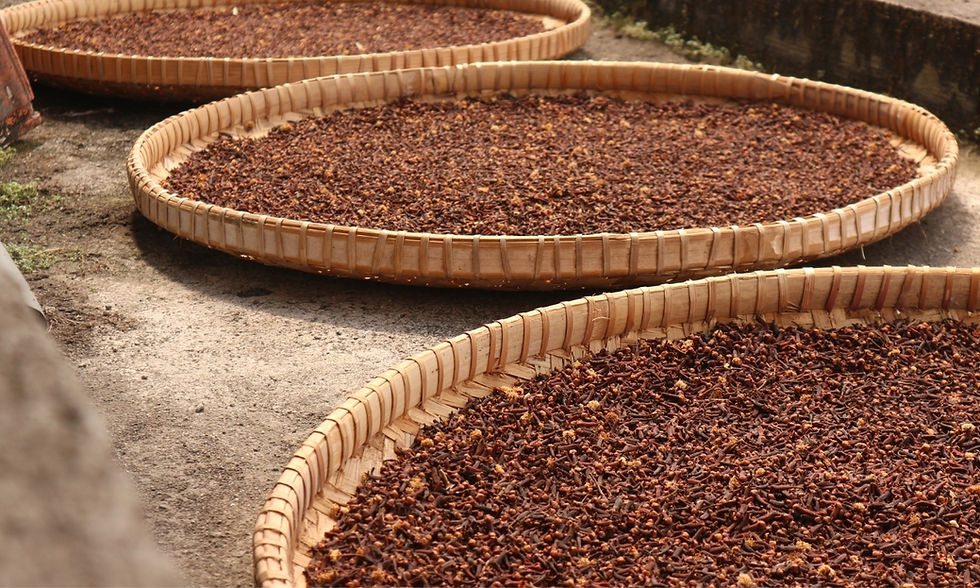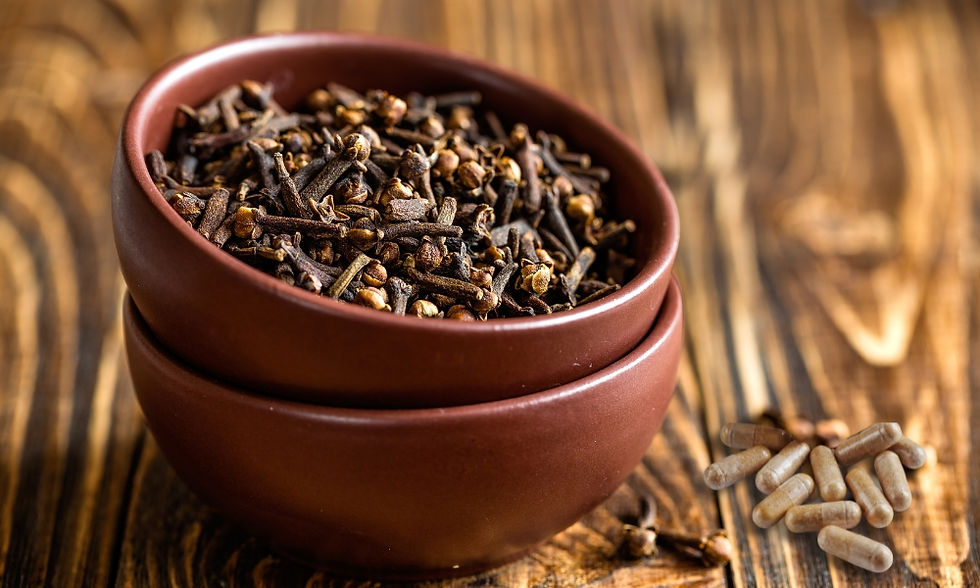Where Do Cloves Come From? Global Origins and Top Producers
- Herbs around us
- Sep 12
- 6 min read
Updated: Sep 26
Cloves are more than just a kitchen spice—they’re part of a centuries-old agricultural legacy, deeply rooted in tropical islands and spice trade routes. Today, as consumers increasingly turn to organic clove supplements, essential oils, and culinary cloves, interest in the origins and quality of these aromatic buds is rising. But where exactly do your cloves come from? Which countries lead the world in growing, harvesting, and exporting this powerhouse botanical? Let’s explore the geographic roots of cloves, the modern supply chain, and why sourcing matters for health and sustainability.

Image: Canva
The Birthplace of Clove: Spice Islands and Beyond
Cloves originate from the Maluku Islands, also known as the Spice Islands, located in eastern Indonesia. These volcanic islands offered the perfect balance of heat, humidity, and mineral-rich soils for the clove tree (Syzygium aromaticum) to thrive. Historians trace the first written mention of cloves to Chinese literature around 200 BCE, where they were chewed for fresh breath before imperial audiences. From there, cloves made their way to India, the Middle East, and Africa via ancient trade routes, eventually becoming a prized commodity in Europe during the colonial spice wars.
Today, the historical significance of cloves still lingers, especially in regions like Zanzibar (Tanzania) and Kerala (India), where centuries of traditional cultivation remain alive.
Geographic Origins: Best Clove Growing Regions
Several tropical regions across the globe now grow cloves at a commercial scale, but only a few countries dominate the global market. Here’s a look at the most prominent clove-producing nations, based on data from FAO, UN Comtrade, and ITC Trade Map.
These five countries account for over 90% of global clove production, with Indonesia alone responsible for nearly 70% of the supply. However, quality, potency, and organic farming practices vary widely across regions.
Why Geographic Origin Matters in Clove Supplements
If you are shopping for clove capsules, clove oil, or clove tinctures, the source of the raw cloves directly impacts the potency, taste, and safety of the final product. Here’s why:
Soil and Climate Conditions: Clove trees thrive in well-drained volcanic soils, high humidity, and equatorial heat. These conditions influence the eugenol content—the key bioactive in cloves responsible for their antioxidant, antimicrobial, and anti-inflammatory effects.
Harvesting Practices: Cloves must be hand-picked when they’re still pink, right before flowering. Overripe or underdeveloped buds reduce the oil concentration. Regions like Madagascar and Zanzibar are known for traditional harvesting techniques that preserve clove quality.
Drying and Processing Methods: Improper drying can lead to mold contamination or reduced eugenol retention. Countries with long-standing spice infrastructure (India, Sri Lanka) often lead in safe processing for nutraceutical-grade products.
Organic Certification and Testing: U.S. consumers increasingly prefer clove supplement capsules, which are most reliably sourced from certified farms in India, Sri Lanka, or Tanzania. These regions offer better traceability compared to bulk, reasonably priced suppliers.
Domestic Use vs. Export: How Different Nations Use Their Clove
Interestingly, not all clove-producing countries prioritize exports. In Indonesia, over 60% of cloves are consumed domestically, mainly in kretek (clove cigarettes), which are popular across Southeast Asia. In contrast:
India and Sri Lanka focus more on clove use in Ayurveda, Unani, and culinary applications, with a growing trend toward supplement manufacturing.
Tanzania and Madagascar heavily rely on exports, with cloves contributing significantly to GDP and rural employment. These countries are major players in the organic whole clove and bulk spice trade with Europe and North America.
For health-conscious consumers, knowing whether your clove capsules come from a cigarette-grade or supplement-grade source matters greatly.
As global demand for organic clove supplements, aromatherapy oils, and culinary spices continues to grow, the trade routes of clove exports have become just as important as the regions where they’re grown. Understanding not only where your cloves are produced, but how they’re processed, packaged, and shipped gives deeper insight into product quality, price variability, and supply chain integrity. This part of the blog explores modern export trends, how to decode sourcing transparency, and what makes certain clove products stand out in today’s health-conscious markets.
One of the leading importers of cloves globally is the United States, which primarily brings in cloves and clove derivatives for use in dietary supplements, essential oils, and food manufacturing. According to the U.S. International Trade Commission, American imports of dried cloves and clove oil reached an estimated $65 million USD in 2023, with the majority coming from Indonesia, Madagascar, and Sri Lanka. European Union countries, especially Germany, France, and the Netherlands, also import large volumes for food processing and herbal product manufacturing, often demanding certified organic and fair-trade labeling. China, on the other hand, primarily uses cloves in traditional Chinese medicine and incense production, sourcing from Indonesia and Tanzania.
Reading a clove product label is not always straightforward, especially when dealing with blends, extracts, or third-party capsules. However, several signals can help identify the country of origin or at least determine product quality. U.S. FDA labeling guidelines require that imported herbal supplements disclose the country where the primary ingredient was grown if it differs from the packaging or manufacturing location. Look for labels that say “Sourced from Madagascar” or “Clove origin: Sri Lanka", especially on organic-certified capsules or clove tinctures. Phrases like “Manufactured in the USA” often refer only to the encapsulation or bottling process, not the source of the cloves themselves. Transparent brands may include batch testing results, COAs, or QR codes linking to detailed supply chain data.
Consumers seeking clove capsules organic or clove oil for internal use should pay particular attention to the following factors: whether the product uses whole dried cloves vs. extract, whether it’s derived from Syzygium aromaticum species specifically (to rule out substitutes), and if the product carries certifications such as USDA Organic, Non-GMO, or Fair Trade. These details are especially important for customers with concerns about heavy metal contamination, microbial residues, or adulteration, which are more likely when cloves are sourced from bulk, unregulated suppliers.
When evaluating whether a clove product is “premium", it’s helpful to understand how potency is measured. For example, eugenol content—the main active compound in cloves—is typically around 15% in dried clove buds but may vary from 10% to 20% depending on growing region and post-harvest handling. Cloves from Indonesia’s North Maluku province and Madagascar’s Sambava region are considered especially rich in eugenol, making them valuable for both culinary use and oil distillation. Some supplement brands now label the standardized eugenol percentage or provide third-party lab verification to back up potency claims. In clove oil capsules, consumers may also see concentrations listed in milligrams, such as “Clove Oil 500 mg", but should look for language confirming that the oil is steam distilled, solvent-free, and suitable for internal use if applicable.
In recent years, several case studies have shown that consumers are becoming more aware of ethical sourcing and ecological impacts tied to spice production. Regions like Zanzibar have invested in sustainable agroforestry projects that regenerate clove trees on degraded land, helping secure future harvests and provide local employment. Indian growers in Kerala and Tamil Nadu are also exploring regenerative organic methods that avoid synthetic pesticides while maintaining yield. These initiatives not only improve environmental resilience but also add long-term value to the clove trade. Buyers who care about climate impact, biodiversity, or local worker protections can now find cloves labeled as Rainforest Alliance Certified or sourced through cooperatives.
For modern consumers choosing between clove oil, clove capsules, or traditional whole cloves, understanding the geographic and production differences has never been more critical. The product on your shelf may have started as a pink bud in Zanzibar, sun-dried in Madagascar, distilled in India, and encapsulated in a U.S. GMP facility. Each step shapes its purity, safety, and efficacy. When brands offer transparent origin documentation and testing results, it’s a sign they value both quality and consumer trust. As demand continues to rise in the U.S. and Australia, educated buyers will shape the future of sustainable clove farming across the tropics.
📊 Infographic: Top Clove-Producing Countries Compared
References
Food and Agriculture Organization of the United Nations. “FAOSTAT: Clove Production". Rome, 2023.
U.S. International Trade Commission. “U.S. Imports of Cloves and Clove Oil". Washington, D.C., 2023.
ITC Trade Map. “Global Clove Export Statistics". Geneva, 2023.
Journal of Essential Oil Research. “Eugenol Content in Clove Buds by Region". 2022.
USDA Organic Program. “Accredited Certifying Agents List". Washington, D.C., 2024.


